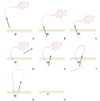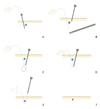Abstract
Inguinal hernia is one of the most common surgical disease that pediatric surgeons deal with. This article provides an overview of pediatric inguinal hernia and a review of the current evidence about variable laparoscopic operative options and their results. In recent years, the use of laparoscopic procedures has gained increased popularity. Most of the laparoscopic repairing methods for pediatric inguinal hernia have similar results with open surgery when it comes to recurrence rates and complication rates. They have shorter operative time for bilateral hernia, less contralateral metachronous hernia and less invasive for vas deference and testicular vessels. The laparoscopic repair can be an alternative of open repair. Further research comparing the different laparoscopic approaches including long term outcome will be needed.
Figures and Tables
 | Figure 1Percutaneous internal ring suturing technique. (A) Prepare the injection needle with non-absorbable thread inside the barrel of the needle. (B) Under laparoscopic-guided the needle is introduced into the body, with the movement of the tip of the under the peritoneum, over half of the internal ring including a part of the ligament and adjacent tissue. (C) The thread is pushed through the barrel of the needle into the abdominal cavity and eventually makes a loop. (D) The needle is pulled out, leaving the loop of the thread inside the abdomen. (E) The needle passes through the same skin puncture point, to surround the other half of the internal ring and the tip of needle pass through the loop. (F) One of the thread ends is introduced again into the barrel of the needle and the end of the thread goes through the barrel of the needle into the thread loop. (G) Next, the needle is withdrawn and the thread loop is pulled out of the abdomen with the thread end caught by the loop. The thread is placed around the inguinal ring and both ends exit the skin through the same puncture point. (H) The knot is tied to close the internal ring and is placed under the skin. |
 | Figure 2Laparoscopic percutaneous internal ring suturing technique. (A) Under laparoscopic guidance, a laparoscopic percutaneous extraperitoneal closure needle with a non-absorbable suture material is inserted percutaneously into the preperitoneal space at the corresponding skin of the internal ring. (B) Holding the end of thread with the forcep, pull the needle out a little bit. The needle is then introduced extraperitoneally in one side of the ring and extracted through the other side at the same skin incision. (C) Push the loop through the needle to make a loop larger inside abdominal cavity. Then put the end of thread to go through the loop. (D) Catching the end of the thread with the tightened loop. (E) Pull the needle with the thread out of the body. (F) Tie the suture externally to obliterate the internal ring. |
References
1. Esposito C, St Peter SD, Escolino M, Juang D, Settimi A, Holcomb GW 3rd. Laparoscopic versus open inguinal hernia repair in pediatric patients: a systematic review. Laparoendosc Adv Surg Tech A. 2014; 24:811–818.

2. Coran AG, Caldamone A, Adzick NS, Krummel TM, Laberge JM, Shamberger R. Pediatric surgery e-book. Vol. 2. [place unknown]: Elsevier Health Sciences;2012.
3. Feehan BP, Fromm DS. Laparoscopic pediatric inguinal hernia repair: overview of “True Herniotomy” technique and review of current evidence. S D Med. 2017; 70:217–223.

4. Han YJ, Nam SH, Kim DY, Kim SC, Kim IK. Contralateral incidence of pediatric inguinal hernia and hydrocele after unilateral operation. J Korean Assoc Pediatr Surg. 2008; 14:48–57.

5. Youn JK, Kim HY, Huh YJ, Han JW, Kim SH, Oh C, Jo AH, Park KW, Jung SE. Inguinal hernia in preterms in neonatal intensive care units: optimal timing of herniorrhaphy and necessity of contralateral exploration in unilateral presentation. J Pediatr Surg. 2018; 53:2155–2159.


6. Juang D, Garey CL, Ostlie DJ, Snyder CL, Holcomb GW 3rd, St Peter SD. Contralateral inguinal hernia after negative laparoscopic evaluation: a rare but real phenomenon. J Laparoendosc Adv Surg Tech A. 2012; 22:200–202.


7. van Veen RN, van Wessem KJ, Halm JA, Simons MP, Plaisier PW, Jeekel J, Lange JF. Patent processus vaginalis in the adult as a risk factor for the occurrence of indirect inguinal hernia. Surg Endosc. 2007; 21:202–205.


8. Erez I, Rathause V, Vacian I, Zohar E, Hoppenstein D, Werner M, Lazar L, Freud E. Preoperative ultrasound and intraoperative findings of inguinal hernias in children: a prospective study of 642 children. J Pediatr Surg. 2002; 37:865–868.


9. Ferguson AH. Oblique inguinal hernia: typic operation for its radical cure. JAMA. 1899; XXXIII:6–14.
10. El-Gohary MA. Laparoscopic ligation of inguinal hernia in girls. Pediatr Endosurg Innov Tech. 1997; 01. DOI: 10.1089/pei.1997.1.185. [Epub].

11. Patkowski D, Czernik J, Chrzan R, Jaworski W, Apoznanski W. Percutaneous internal ring suturing: a simple minimally invasive technique for inguinal hernia repair in children. J Laparoendosc Adv Surg Tech A. 2006; 16:513–517.


12. Kim MJ, Moon SB, Seo JM, Lee SK. Comparison of the results of contralateral exploration in pediatric inguinal hernia. J Korean Assoc Pediatr Surg. 2009; 15:149–156.

13. Yang C, Zhang H, Pu J, Mei H, Zheng L, Tong Q. Laparoscopic vs open herniorrhaphy in the management of pediatric inguinal hernia: a systemic review and meta-analysis. J Pediatr Surg. 2011; 46:1824–1834.


14. Ho IG, Ihn K, Koo EJ, Chang EY, Oh JT. Laparoscopic repair of inguinal hernia in infants: comparison with open hernia repair. J Pediatr Surg. 2018; 53:2008–2012.


15. Shalaby R, Elsayaad I, Alsamahy O, Ibrahem R, El-Saied A, Ismail M, Shamseldin A, Shehata S, Magid M. One trocar needlescopic assisted inguinal hernia repair in children: a novel technique. J Pediatr Surg. 2017; 08. 31. DOI: 10.1016/j.jpedsurg.2017.08.020. [Epub].

16. Helal AA. Laparoscopic single instrument closure of inguinal hernia in female children: a novel technique. J Pediatr Surg. 2015; 50:1613–1616.


17. Lee DY, Baik YH, Kwak BS, Oh MG, Choi WY. A purse-string suture at the level of internal inguinal ring, taking only the peritoneum leaving the distal sac: is it enough for inguinal hernia in pediatric patients? Hernia. 2015; 19:607–610.


18. Miyake H, Fukumoto K, Yamoto M, Nouso H, Kaneshiro M, Nakajima H, Koyama M, Urushihara N. Comparison of percutaneous extraperitoneal closure (LPEC) and open repair for pediatric inguinal hernia: experience of a single institution with over 1000 cases. Surg Endosc. 2016; 30:1466–1472.


19. Chen Y, Wang F, Zhong H, Zhao J, Li Y, Shi Z. A systematic review and meta-analysis concerning single-site laparoscopic percutaneous extraperitoneal closure for pediatric inguinal hernia and hydrocele. Surg Endosc. 2017; 31:4888–4901.


20. Wolak PK, Patkowski D. Laparoscopic inguinal hernia repair in children using the percutaneous internal ring suturing technique: own experience. Wideochir Inne Tech Maloinwazyjne. 2014; 9:53–58.


21. Thomas DT, Gocmen KB, Tulgar S, Boga I. Percutaneous internal ring suturing is a safe and effective method for the minimal invasive treatment of pediatric inguinal hernia: experience with 250 cases. J Pediatr Surg. 2016; 51:1330–1335.


22. Erginel B, Akin M, Yildiz A, Karadag CA, Sever N, Dokucu AI. Percutaneous internal ring suturing as a first choice laparoscopic inguinal hernia repair method in girls: a single-center study in 148 patients. Pediatr Surg Int. 2016; 32:697–700.


23. Li S, Li M, Wong KK, Liu L, Tam PK. Laparoscopically assisted simple suturing obliteration (LASSO) of the internal ring using an epidural needle: a handy single-port laparoscopic herniorrhaphy in children. J Pediatr Surg. 2014; 49:1818–1820.


24. Hamad MA, Osman MA, Abdelhamed M. Laparoscopic-assisted percutaneous internal ring ligation in children. Ann Pediatr Surg. 2011; 7:66–69.

25. Oue T, Kubota A, Okuyama H, Kawahara H. Laparoscopic percutaneous extraperitoneal closure (LPEC) method for the exploration and treatment of inguinal hernia in girls. Pediatr Surg Int. 2005; 21:964–968.


26. Li S, Liu L, Li M. Single-port laparoscopic percutaneous extraperitoneal closure using an innovative apparatus for pediatric inguinal hernia. J Laparoendosc Adv Surg Tech A. 2014; 24:188–193.


27. Li C, Xu L, Peng Y, Liang X, Lin W. Effects of single-port laparoscopic percutaneous extraperitoneal closure on the orientation of the vas deferens and testicular perfusion and volume: experience from a single center. J Pediatr Urol. 2016; 12:170.


28. Celebi S, Yıldız A, Ucgul A, Karadag CA, Sever N, Akın M, Dokucu AI. Do open repair and different laparoscopic techniques in pediatric inguinal hernia repairs affect the vascularization of testes. J Pediatr Surg. 2012; 47:1706–1710.


29. Giseke S, Glass M, Tapadar P, Matthyssens L, Philippe P. A true laparoscopic herniotomy in children: evaluation of long-term outcome. J Laparoendosc Adv Surg Tech A. 2010; 20:191–194.


30. Tam YH, Wong YS, Pang KK, Tsui SY, Mou JW, Houben CH, Chan KW, Lee KH. Unexpected metachronous hernia development in children following laparoscopic unilateral hernia repair with negative evaluation for contralateral patent processus vaginalis. J Laparoendosc Adv Surg Tech A. 2013; 23:287–290.


31. Sumida W, Watanabe Y, Takasu H, Oshima K, Komatsuzaki N. Effects of insistent screening for contralateral patent processus vaginalis in laparoscopic percutaneous extraperitoneal closure to prevent metachronous contralateral onset of pediatric inguinal hernia. Surg Today. 2016; 46:569–574.


32. Rothenberg RE, Barnett T. Bilateral herniotomy in infants and children. Surgery. 1955; 37:947–950.

33. Miltenburg DM, Nuchtern JG, Jaksic T, Kozinetz CA, Brandt ML. Meta-analysis of the risk of metachronous hernia in infants and children. Am J Surg. 1997; 174:741–744.

34. Saka R, Okuyama H, Sasaki T, Nose S, Yoneyama C. Safety and efficacy of laparoscopic percutaneous extraperitoneal closure for inguinal hernias and hydroceles in children: a comparison with traditional open repair. J Laparoendosc Adv Surg Tech A. 2014; 24:55–58.


35. Miyake H, Fukumoto K, Yamoto M, Nakajima H, Sekioka A, Yamada Y, Nomura A, Urushihara N. Risk factors for recu-rrence and contralateral inguinal hernia after laparoscopic percutaneous extraperitoneal closure for pediatric inguinal hernia. J Pediatr Surg. 2017; 52:317–321.


36. Xiang B, Jin S, Zhong L, Li F, Jiang X, Xu Z. Reasons for recurrence after the laparoscopic repair of indirect inguinal hernia in children. J Laparoendosc Adv Surg Tech A. 2015; 25:681–683.


37. Taylor K, Sonderman KA, Wolf LL, Jiang W, Armstrong LB, Koehlmoos TP, Weil BR, Ricca RL Jr, Weldon CB, Haider AH, Rice-Townsend SE. Hernia recurrence following inguinal hernia repair in children. J Pediatr Surg. 2018; 53:2214–2218.


38. St-Louis E, Chabot A, Stagg H, Baird R. Experience with peritoneal thermal injury during subcutaneous endoscopically assisted ligation for pediatric inguinal hernia. J Pediatr Surg. 2018; 53:968–972.


39. Fujiogi M, Michihata N, Matsui H, Fushimi K, Yasunaga H, Fujishiro J. Outcomes following laparoscopic versus open surgery for pediatric inguinal hernia repair: analysis using a national inpatient database in Japan. J Pediatr Surg. 2018; 03. 17. DOI: 10.1016/j.jpedsurg.2018.03.015. [Epub].





 PDF
PDF ePub
ePub Citation
Citation Print
Print



 XML Download
XML Download